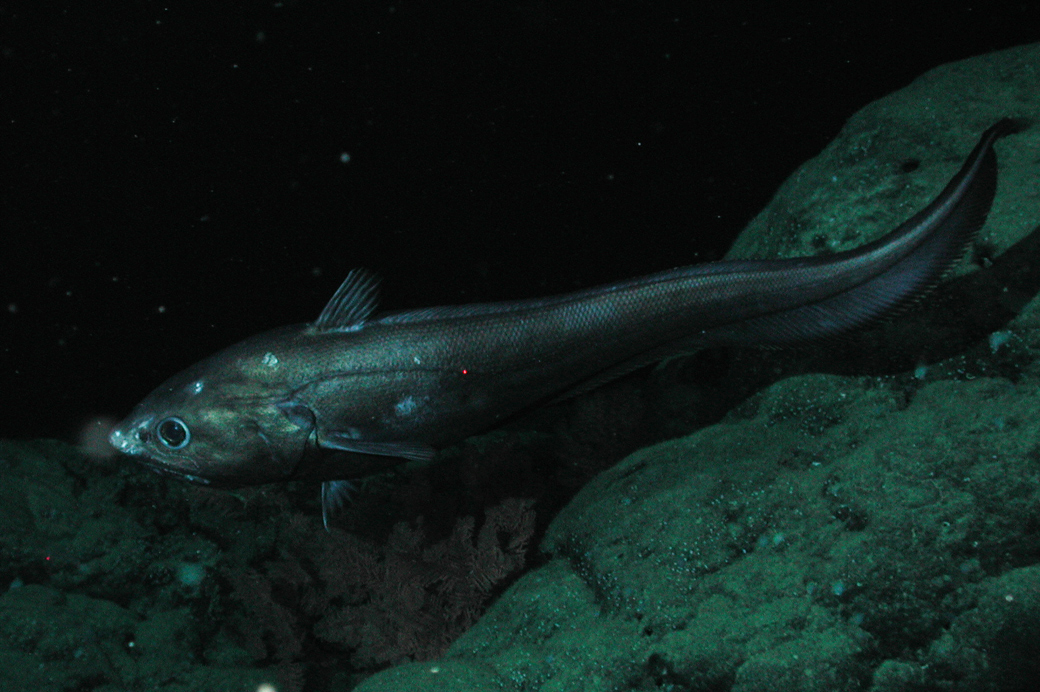Abyssal Grenadier, Coryphaenoides armatus (Hector 1875)
Other Names: Abyssal Macrourid, Armed Grenadier, Cosmopolitan Rattail, Russet Grenadier, Smooth-scale Rattail

An Abyssal grenadier, Coryphaenoides armatus, on the Davidson Seamount at 2253 m depth. Source: NOAA/MBARI. License: Public Domain
Summary:
A large uniformly brownish grenadier with a bluish abdomen, a large head, large eyes and the body tapering from behind the first dorsal fin. The light organ on the underside extends beyond the midpoint between the anal-fin origin and the pelvic-fin bases.
Cite this page as:
Bray, D.J. 2018, Coryphaenoides armatus in Fishes of Australia, accessed 18 Apr 2024, https://fishesofaustralia.net.au/Home/species/4990
Abyssal Grenadier, Coryphaenoides armatus (Hector 1875)
More Info
|
Distribution |
Common in deep waters of most oceans at relatively high latitudes. Known from off Eastern Australia, Tasmania, the Great Australian Bight, and Australia's subantarctic waters. A common inhabitant on the deep-slope, upper continental rise and abyssal plain in the bathypelagic zone of the most ocean basins. |
|
Feeding |
Juveniles feed mostly on benthic invertebrates such as crustaceans and holothurians, while adults feed on mesopelagic and bathypelagic fishes, sea urchins and cephalopod molluscs. |
|
Fisheries |
Although not commercially targeted, the species is is taken as bycatch in deepwater fisheries in parts of its range. |
|
Species Citation |
Macrurus armatus Hector 1875, Ann. Mag. Nat. Hist. (4)15: 78-82. Type locality: about 200 miles west of Cape Farewell, New Zealand, depth 400 fathoms. |
|
Author |
Bray, D.J. 2018 |
Abyssal Grenadier, Coryphaenoides armatus (Hector 1875)
References
Cohen, D.M., T. Inada, T. Iwamoto & N. Scialabba. 1990. FAO species catalogue. Vol. 10. Gadiform fishes of the world (Order Gadiformes). An annotated and illustrated catalogue of cods, hakes, grenadiers and other gadiform fishes known to date. FAO Fisheries Synopsis 125(10). Rome: FAO. 442 pp.
Drazen, J.C. 2002. A seasonal analysis of the nutritional condition of deep-sea macrourid fishes in the north-east Pacific. Journal of Fish Biology 60: 1280-1295.
Fernandes, P., Cook, R., Florin, A.-B., Lorance, P., Nielsen, J. & Nedreaas, K. 2015. Coryphaenoides armatus. The IUCN Red List of Threatened Species 2015: e.T18125776A60791529. http://dx.doi.org/10.2305/IUCN.UK.2015-4.RLTS.T18125776A60791529.en. Downloaded on 22 February 2018.
Fossen, I., Cotton, C., Bergstad, O. and Dyb, J. 2008. Species composition and distribution patterns of fishes captured by longlines on the Mid-Atlantic Ridge. Deep-Sea Research II 55: 203-217
Haedrich, R.L. & N.R. Henderson. 1974. Pelagic food of Coryphaenoides armatus, a deep benthic rattail. Deep-Sea Research 21: 739-744.
Hector, J. 1875. Descriptions of five new species of fishes obtained in New Zealand seas by H.M.S. 'Challenger' Expedition. Annals and Magazine of Natural History (4)15: 78-82. See ref at BHL
Iwamoto, T. 1990. Macrouridae. pp. 192-206. In O. Gon & P.C. Heemstra (eds.) Fishes of the Southern Ocean. J.L.B. Smith Institute of Ichthyology, Grahamstown, South Africa.
Priede,I., Godbold, J., King, N., Collins, M., Bailey, D. & Gordon, J. 2010. Deep-sea demersal fish species richness in the Porcupine Seabight, NE Atlantic Ocean: global and regional patterns. Marine Ecology 31(1): 247-260.
Smith, K.L. Jr. 1978. Metabolism of the abyssopelagic rattail Coryphaenoides armatus measured in situ. Nature 274: 362-364.
Stein, D.L. & Pearcy, W.G. 1982. Aspects of reproduction, early life history, and biology of macrourid fishes off Oregon, U.S.A. Deep-Sea Research 29(11A): 1313-1329.



